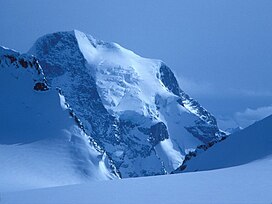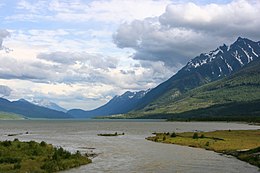Columbia Mountains
| Columbia Mountains | |
|---|---|
 Mount Sir Sandford from the Gothics Glacier | |
| Highest point | |
| Peak | Mount Sir Sandford |
| Elevation | 3,519 m (11,545 ft) |
| Coordinates | 51°39′24″N117°52′03″W/ 51.65667°N 117.86750°W |
| Dimensions | |
| Length | 741 km (460 mi) N-S |
| Width | 493 km (306 mi) W-E |
| Area | 135,952 km2(52,491 sq mi) |
| Geography | |
 Location map of Columbia Mountains: dotted lines to left mark boundaries ofOkanagan,ShuswapandQuesnel Highlands,dotted lines to lower right markSalishandCabinet Mountains.
| |
| Countries | CanadaandUnited States |
| Provinces/States | British Columbia,Idaho,MontanaandWashington |
| Parent range | North American Cordillera |

TheColumbia Mountainsare a group ofmountain rangesalong the UpperColumbia RiverinBritish Columbia,Montana,IdahoandWashington.The mountain range covers 135,952 km² (52,491 sq mi). The range is bounded by theRocky Mountain Trenchon the east, and theKootenai Riveron the south; their western boundary is the edge of theInterior Plateau.Seventy-five percent of the range is located in Canada and the remaining twenty-five percent in theUnited States;American geographic classifications place the Columbia Mountains as part of theRocky Mountainscomplex, but this designation does not apply in Canada (despite a British Columbia government tourism campaign to rebrand their southern portion as the "Kootenay Rockies" ).Mount Sir Sandfordis the highest mountain in the range, reaching 3,519 metres (11,545 ft).
Mountain ranges
[edit]TheColumbia Mountainsare made up of four large ranges containing many subranges:
- Cariboo Mountains
- Monashee Mountains
- Selkirk Mountains
- Purcell Mountains(Percell Mountains in theUnited States)
Additionally lower areas to the west of the main ranges are sometimes included in the description of the Cariboo Mountains:
Some classification systems end theColumbia Mountainsat theNorth Thompson River,such that theCariboo Mountainsare assigned to theInterior Plateau.Where theColumbia Mountainsmeet theInterior Plateauthere are intermediary areas known ashighlands- the Quesnel Highland (west flank of theCariboos), the Shuswap Highland (south of theCariboosand west of the northernMonashees), and the Okanagan Highland (west of the southernMonashees). These are listed here but are often considered to be part of theInterior Plateau.
Some geographic classifications also include theCabinet MountainsandSalish Mountains,which lie south of the Purcells between theKootenai Riverand theClark Fork of the Columbia,but in US classification systems they are generally considered to be part of the Rocky Mountains.
Physiographically, they are a distinct province of the largerRocky Mountain Systemphysiographic division.
Highest Mountains
[edit]The following mountains are the 10 highest mountains (in order) contained within the Columbian Mountains:"Columbia Mountains".Peakbagger.com.
- Mount Sir Sandford(3,519 m) (Selkirks)
- Mount Sir Wilfrid Laurier(3,516 m) (Cariboos)
- Mount Farnham(3,493 m) (Purcells)
- Jumbo Mountain(3,437 m) (Purcells)
- Howser Spire(3,412 m) (Purcells)
- Mount Delphine(3,406 m) (Purcells)
- Mount Sir John Abbott(3,398 m) (Cariboos)
- Mount Hammond(3,387 m) (Purcells)
- Mount Dawson(3,377 m) (Selkirks)
- Eyebrow Peak(3,362 m) (Purcells)
Passes
[edit]
The following passes are located within or on the perimeter of the Columbia Mountains:
- Cedarside Pass(Fraser and Columbia Rivers 800m)
- Canal Flats(Columbia and Kootenay Rivers)
- Rogers Pass(between Revelstoke and Golden)
- Kootenay Pass(between Trail and Creston)
- Eagle Pass(between Revelstoke and Sicamous)
- Monashee Pass(BC Hwy 6)
- Bonanza Pass(Christina Lake to Castlegar/Rossland)
National and provincial parks
[edit]
- Ansty Hunakwa Protected Area
- Bowron Lake Provincial Park
- Bugaboo Provincial Park
- Cariboo Mountains Provincial Park
- Dunn Peak Protected Area
- Glacier National Park
- Gladstone Provincial Park
- Goat Range Provincial Park
- Granby Provincial Park
- Graystokes Provincial Park
- Kianuko Provincial Park
- Kokanee Glacier Provincial Park
- Monashee Provincial Park
- Mount Revelstoke National Park
- Myra-Bellevue Provincial Park
- Okanagan Mountain Provincial Park
- Purcell Wilderness Conservancy Provincial Park and Protected Area
- St. Mary's Alpine Provincial Park
- Silver Star Provincial Park
- Valhalla Provincial Park
- Wells Gray Provincial Park
- West Arm Provincial Park
- West Twin Provincial Park and Protected Area
See also
[edit]References
[edit]This articleneeds additional citations forverification.(December 2007) |
